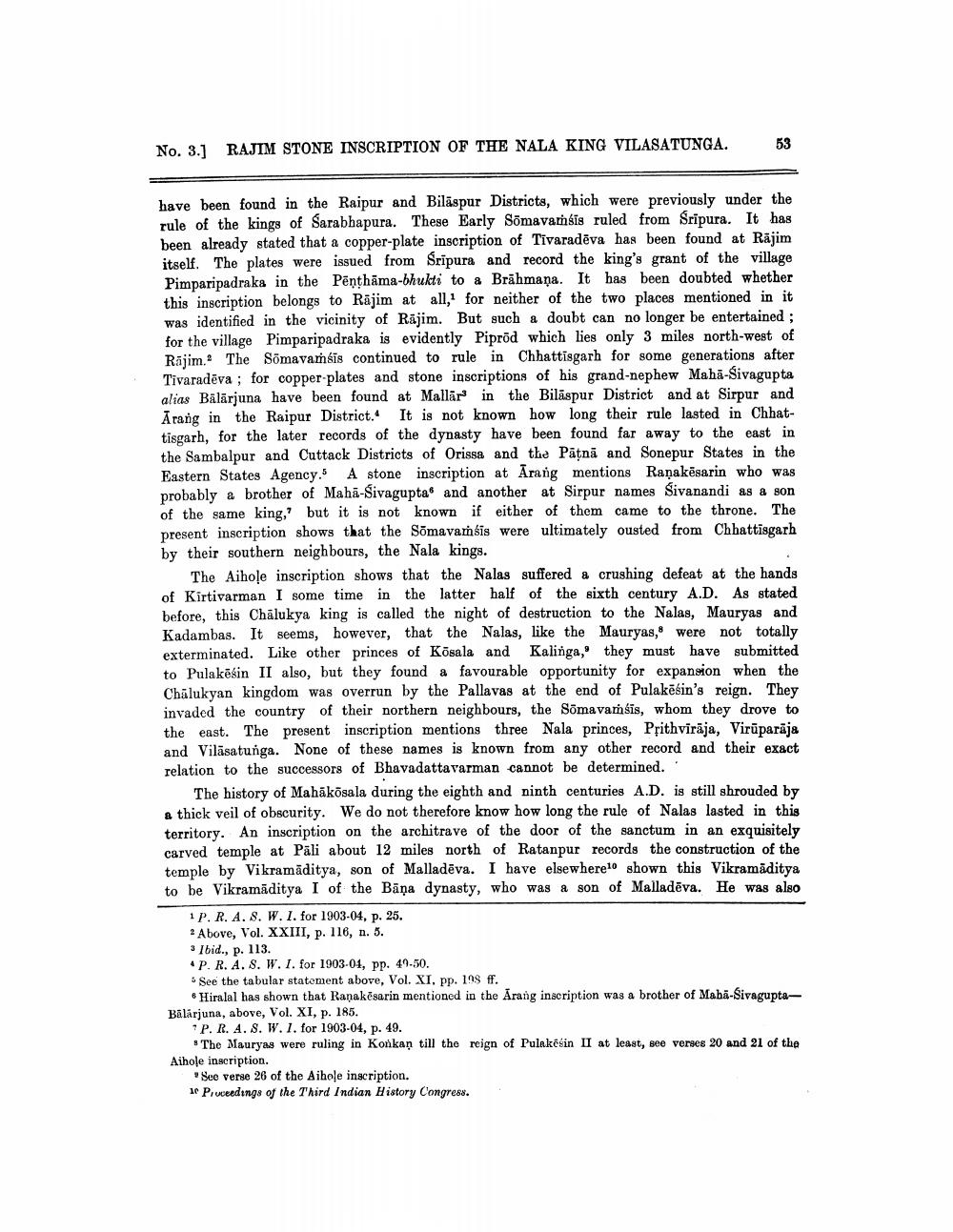________________
No. 3.) RAJIM STONE INSCRIPTION OF THE NALA KING VILASATUNGA.
have been found in the Raipur and Bilaspur Districts, which were previously under the rule of the kings of Sarabhapura. These Early Sõmavamsis ruled from Srīpura. It has been already stated that a copper-plate inscription of Tivaradēva has been found at Räjim itself. The plates were issued from Sripura and record the king's grant of the village Pimparipadraka in the Pēņthāma-bhukti to a Brāhmaṇa. It has been doubted whether this inscription belongs to Räjim at all, for neither of the two places mentioned in it was identified in the vicinity of Rājim. But such a doubt can no longer be entertained ; for the village Pimparipadraka is evidently Piprod which lies only 3 miles north-west of Rajim. The Sõmavaṁsīs continued to rule in Chhattisgarh for some generations after Tivaradeva ; for copper plates and stone inscriptions of his grand-nephew Mahā-Sivagupta alias Balärjuna have been found at Mallārs in the Bilaspur District and at Sirpur and Arang in the Raipur District. It is not known how long their rule lasted in Chhattisgarh, for the later records of the dynasty have been found far away to the east in the Sambalpur and Cuttack Districts of Orissa and the Pātnā and Sonepur States in the Eastern States Agency. A stone inscription at Arang mentions Raņakēsarin who was probably a brother of Mahā-Sivagupta and another at Sirpur names Sivanandi as a son of the same king, but it is not known if either of them came to the throne. The present inscription shows that the Sõmavamsis were ultimately ousted from Chhattisgarh by their southern neighbours, the Nala kings.
The Aihoļe inscription shows that the Nalas suffered & crushing defeat at the hands of Kirtivarman I some time in the latter half of the sixth century A.D. As stated before, this Chalukya king is called the night of destruction to the Nalas, Mauryas and Kadambas. It seems, however, that the Nalas, like the Mauryas, were not totally exterminated. Like other princes of Kõsala and Kalinga, they must have submitted to Pulakēsin II also, but they found a favourable opportunity for expansion when the Chalukyan kingdom was overrun by the Pallavas at the end of Pulakēsin's reign. They invaded the country of their northern neighbours, the Sõmavam īs, whom they drove to the east. The present inscription mentions three Nala princes, Prithvirāja, Virüparāja and Vilăsatunga. None of these names is known from any other record and their exact relation to the successors of Bhavadattavarman cannot be determined.'
The history of Mahākõsala during the eighth and ninth centuries A.D. is still shrouded by a thick veil of obscurity. We do not therefore know how long the rule of Nalas lasted in this territory. An inscription on the architrave of the door of the sanctum in an exquisitely carved temple at Päli about 12 miles north of Ratanpur records the construction of the temple by Vikramaditya, son of Malladēva. I have elsewhere to shown this Vikramaditya to be Vikramaditya I of the Bāņa dynasty, who was a son of Malladēva. He was also
1 P. R. A. S. W. 1. for 1903-04, p. 25. 2 Above, Vol. XXIII, p. 116, n. 5. 3 Ibid., p. 113.
P. R. A. S. W. I. for 1903-04, pp. 49-50. * See the tabular statement above, Vol. XI, pp. 198 ff.
Hiralal has shown that Ranakēsarin mentioned in the Arang inscription was a brother of Maba-SivaguptaBalärjuna, above, Vol. XI, p. 185.
P. R. A. S. W. 1. for 1903-04, p. 49.
The Mauryas were ruling in Konkan till the reign of Pulake in II at least, see verses 20 and 21 of the Aihole inscription.
See verse 26 of the Aihole inscription. 10 Pr weedings of the Third Indian History Congress.




